Civil Law: Duty of Care, Standard of Care, Loss, Damages
VerifiedAdded on 2023/04/26
|5
|971
|255
AI Summary
This document discusses the duty of care, standard of care, loss, and damages in civil law. It also provides possible defenses of the bowling alley and the outcome. The document categorizes the four types of damages that John could claim and provides examples of each.
Contribute Materials
Your contribution can guide someone’s learning journey. Share your
documents today.
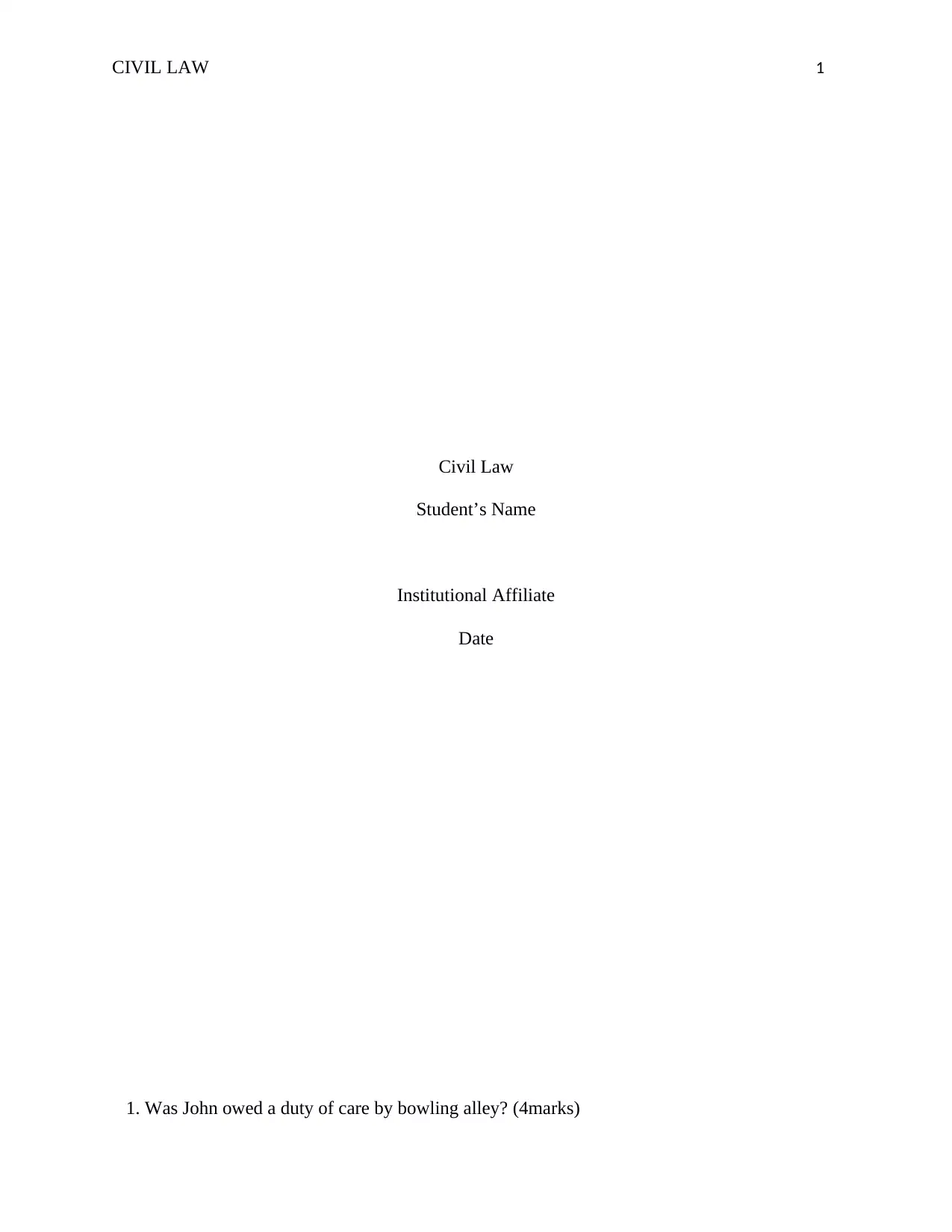
CIVIL LAW 1
Civil Law
Student’s Name
Institutional Affiliate
Date
1. Was John owed a duty of care by bowling alley? (4marks)
Civil Law
Student’s Name
Institutional Affiliate
Date
1. Was John owed a duty of care by bowling alley? (4marks)
Secure Best Marks with AI Grader
Need help grading? Try our AI Grader for instant feedback on your assignments.
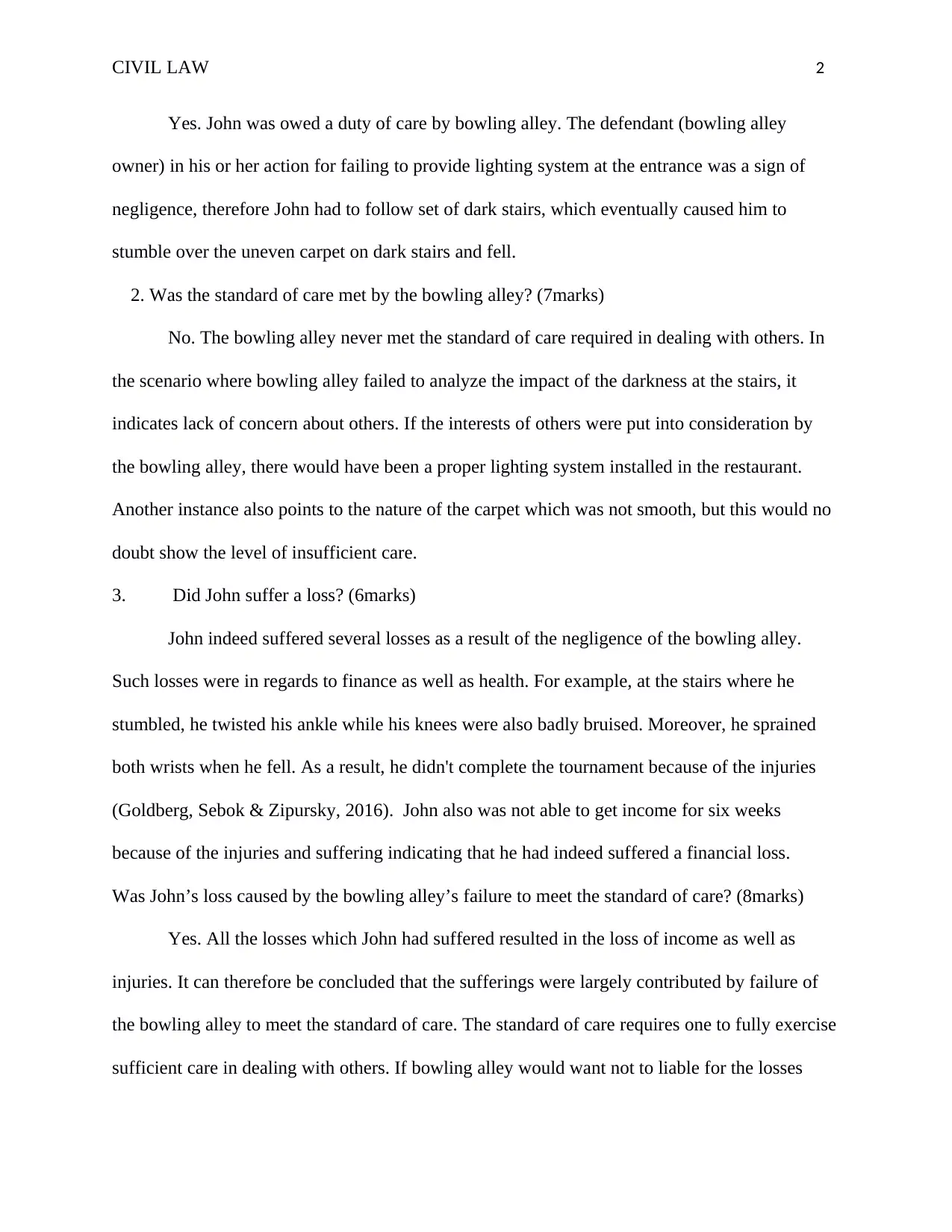
CIVIL LAW 2
Yes. John was owed a duty of care by bowling alley. The defendant (bowling alley
owner) in his or her action for failing to provide lighting system at the entrance was a sign of
negligence, therefore John had to follow set of dark stairs, which eventually caused him to
stumble over the uneven carpet on dark stairs and fell.
2. Was the standard of care met by the bowling alley? (7marks)
No. The bowling alley never met the standard of care required in dealing with others. In
the scenario where bowling alley failed to analyze the impact of the darkness at the stairs, it
indicates lack of concern about others. If the interests of others were put into consideration by
the bowling alley, there would have been a proper lighting system installed in the restaurant.
Another instance also points to the nature of the carpet which was not smooth, but this would no
doubt show the level of insufficient care.
3. Did John suffer a loss? (6marks)
John indeed suffered several losses as a result of the negligence of the bowling alley.
Such losses were in regards to finance as well as health. For example, at the stairs where he
stumbled, he twisted his ankle while his knees were also badly bruised. Moreover, he sprained
both wrists when he fell. As a result, he didn't complete the tournament because of the injuries
(Goldberg, Sebok & Zipursky, 2016). John also was not able to get income for six weeks
because of the injuries and suffering indicating that he had indeed suffered a financial loss.
Was John’s loss caused by the bowling alley’s failure to meet the standard of care? (8marks)
Yes. All the losses which John had suffered resulted in the loss of income as well as
injuries. It can therefore be concluded that the sufferings were largely contributed by failure of
the bowling alley to meet the standard of care. The standard of care requires one to fully exercise
sufficient care in dealing with others. If bowling alley would want not to liable for the losses
Yes. John was owed a duty of care by bowling alley. The defendant (bowling alley
owner) in his or her action for failing to provide lighting system at the entrance was a sign of
negligence, therefore John had to follow set of dark stairs, which eventually caused him to
stumble over the uneven carpet on dark stairs and fell.
2. Was the standard of care met by the bowling alley? (7marks)
No. The bowling alley never met the standard of care required in dealing with others. In
the scenario where bowling alley failed to analyze the impact of the darkness at the stairs, it
indicates lack of concern about others. If the interests of others were put into consideration by
the bowling alley, there would have been a proper lighting system installed in the restaurant.
Another instance also points to the nature of the carpet which was not smooth, but this would no
doubt show the level of insufficient care.
3. Did John suffer a loss? (6marks)
John indeed suffered several losses as a result of the negligence of the bowling alley.
Such losses were in regards to finance as well as health. For example, at the stairs where he
stumbled, he twisted his ankle while his knees were also badly bruised. Moreover, he sprained
both wrists when he fell. As a result, he didn't complete the tournament because of the injuries
(Goldberg, Sebok & Zipursky, 2016). John also was not able to get income for six weeks
because of the injuries and suffering indicating that he had indeed suffered a financial loss.
Was John’s loss caused by the bowling alley’s failure to meet the standard of care? (8marks)
Yes. All the losses which John had suffered resulted in the loss of income as well as
injuries. It can therefore be concluded that the sufferings were largely contributed by failure of
the bowling alley to meet the standard of care. The standard of care requires one to fully exercise
sufficient care in dealing with others. If bowling alley would want not to liable for the losses
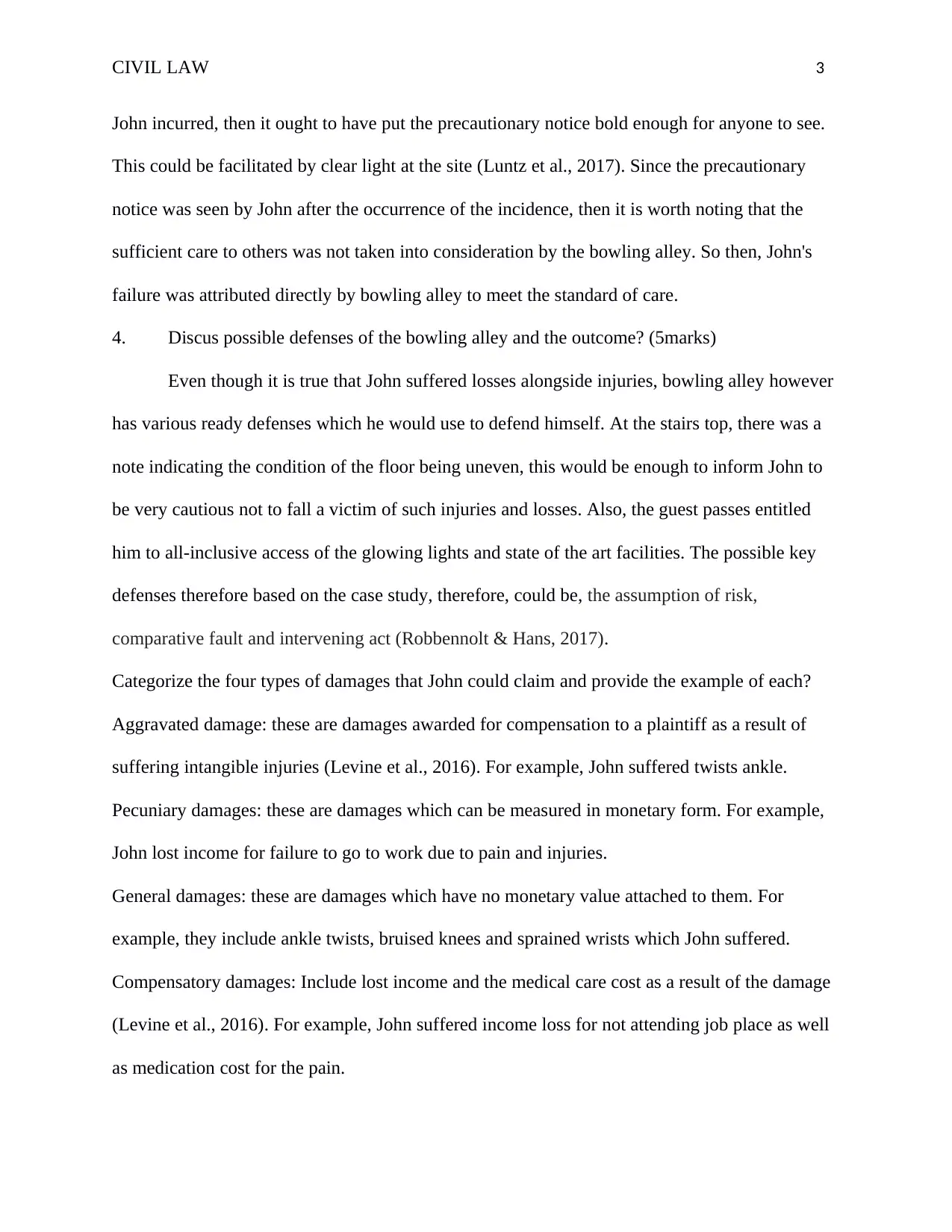
CIVIL LAW 3
John incurred, then it ought to have put the precautionary notice bold enough for anyone to see.
This could be facilitated by clear light at the site (Luntz et al., 2017). Since the precautionary
notice was seen by John after the occurrence of the incidence, then it is worth noting that the
sufficient care to others was not taken into consideration by the bowling alley. So then, John's
failure was attributed directly by bowling alley to meet the standard of care.
4. Discus possible defenses of the bowling alley and the outcome? (5marks)
Even though it is true that John suffered losses alongside injuries, bowling alley however
has various ready defenses which he would use to defend himself. At the stairs top, there was a
note indicating the condition of the floor being uneven, this would be enough to inform John to
be very cautious not to fall a victim of such injuries and losses. Also, the guest passes entitled
him to all-inclusive access of the glowing lights and state of the art facilities. The possible key
defenses therefore based on the case study, therefore, could be, the assumption of risk,
comparative fault and intervening act (Robbennolt & Hans, 2017).
Categorize the four types of damages that John could claim and provide the example of each?
Aggravated damage: these are damages awarded for compensation to a plaintiff as a result of
suffering intangible injuries (Levine et al., 2016). For example, John suffered twists ankle.
Pecuniary damages: these are damages which can be measured in monetary form. For example,
John lost income for failure to go to work due to pain and injuries.
General damages: these are damages which have no monetary value attached to them. For
example, they include ankle twists, bruised knees and sprained wrists which John suffered.
Compensatory damages: Include lost income and the medical care cost as a result of the damage
(Levine et al., 2016). For example, John suffered income loss for not attending job place as well
as medication cost for the pain.
John incurred, then it ought to have put the precautionary notice bold enough for anyone to see.
This could be facilitated by clear light at the site (Luntz et al., 2017). Since the precautionary
notice was seen by John after the occurrence of the incidence, then it is worth noting that the
sufficient care to others was not taken into consideration by the bowling alley. So then, John's
failure was attributed directly by bowling alley to meet the standard of care.
4. Discus possible defenses of the bowling alley and the outcome? (5marks)
Even though it is true that John suffered losses alongside injuries, bowling alley however
has various ready defenses which he would use to defend himself. At the stairs top, there was a
note indicating the condition of the floor being uneven, this would be enough to inform John to
be very cautious not to fall a victim of such injuries and losses. Also, the guest passes entitled
him to all-inclusive access of the glowing lights and state of the art facilities. The possible key
defenses therefore based on the case study, therefore, could be, the assumption of risk,
comparative fault and intervening act (Robbennolt & Hans, 2017).
Categorize the four types of damages that John could claim and provide the example of each?
Aggravated damage: these are damages awarded for compensation to a plaintiff as a result of
suffering intangible injuries (Levine et al., 2016). For example, John suffered twists ankle.
Pecuniary damages: these are damages which can be measured in monetary form. For example,
John lost income for failure to go to work due to pain and injuries.
General damages: these are damages which have no monetary value attached to them. For
example, they include ankle twists, bruised knees and sprained wrists which John suffered.
Compensatory damages: Include lost income and the medical care cost as a result of the damage
(Levine et al., 2016). For example, John suffered income loss for not attending job place as well
as medication cost for the pain.
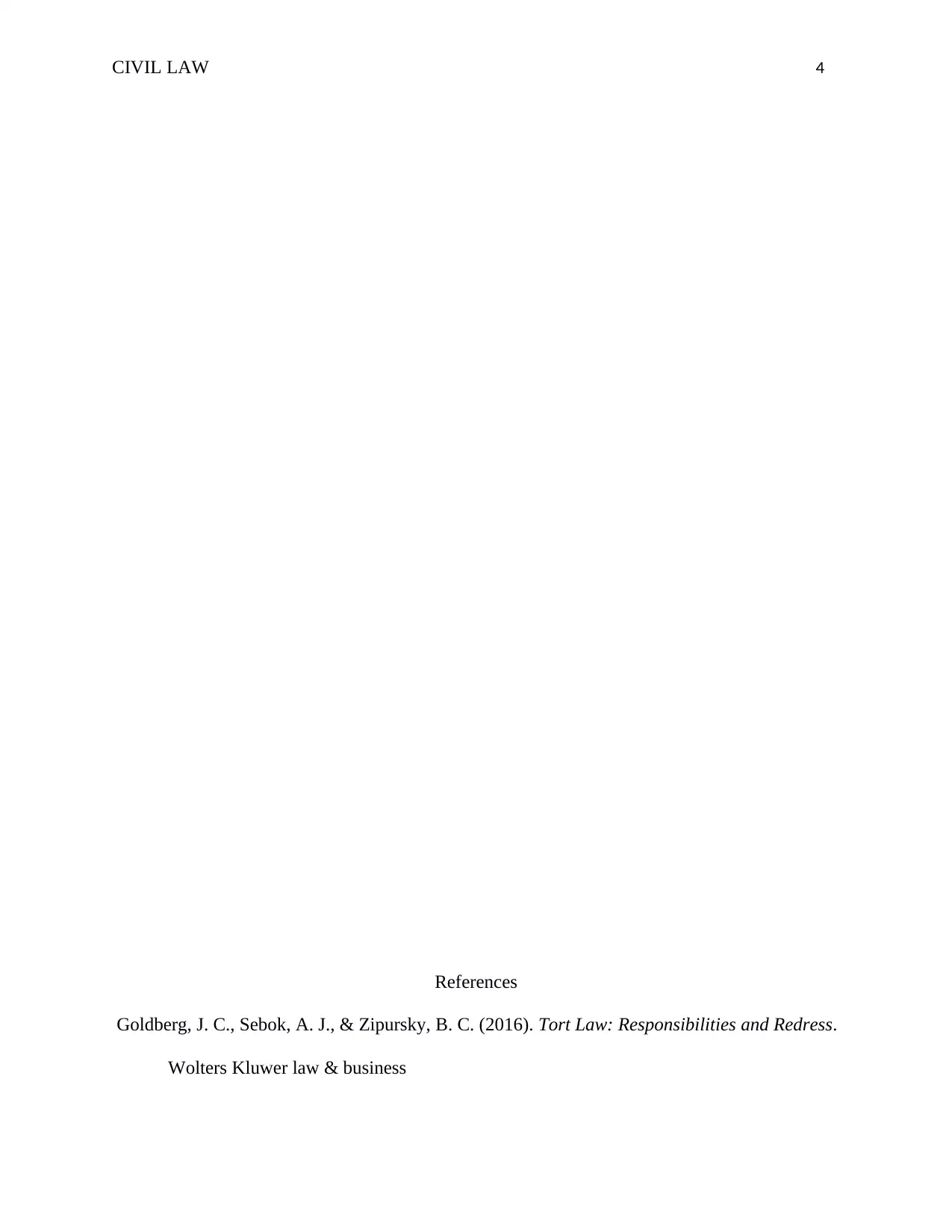
CIVIL LAW 4
References
Goldberg, J. C., Sebok, A. J., & Zipursky, B. C. (2016). Tort Law: Responsibilities and Redress.
Wolters Kluwer law & business
References
Goldberg, J. C., Sebok, A. J., & Zipursky, B. C. (2016). Tort Law: Responsibilities and Redress.
Wolters Kluwer law & business
Secure Best Marks with AI Grader
Need help grading? Try our AI Grader for instant feedback on your assignments.
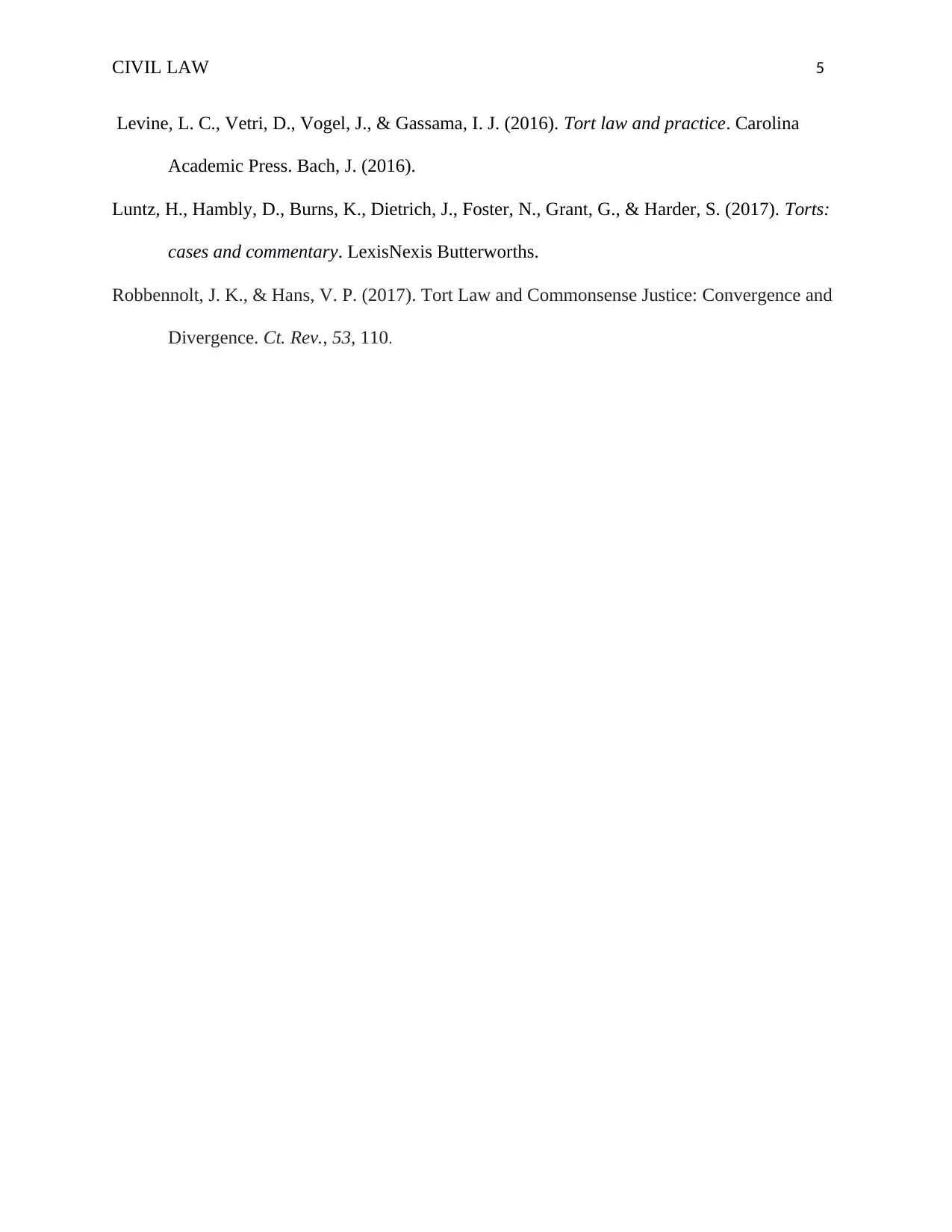
CIVIL LAW 5
Levine, L. C., Vetri, D., Vogel, J., & Gassama, I. J. (2016). Tort law and practice. Carolina
Academic Press. Bach, J. (2016).
Luntz, H., Hambly, D., Burns, K., Dietrich, J., Foster, N., Grant, G., & Harder, S. (2017). Torts:
cases and commentary. LexisNexis Butterworths.
Robbennolt, J. K., & Hans, V. P. (2017). Tort Law and Commonsense Justice: Convergence and
Divergence. Ct. Rev., 53, 110.
Levine, L. C., Vetri, D., Vogel, J., & Gassama, I. J. (2016). Tort law and practice. Carolina
Academic Press. Bach, J. (2016).
Luntz, H., Hambly, D., Burns, K., Dietrich, J., Foster, N., Grant, G., & Harder, S. (2017). Torts:
cases and commentary. LexisNexis Butterworths.
Robbennolt, J. K., & Hans, V. P. (2017). Tort Law and Commonsense Justice: Convergence and
Divergence. Ct. Rev., 53, 110.
1 out of 5
Related Documents
Your All-in-One AI-Powered Toolkit for Academic Success.
+13062052269
info@desklib.com
Available 24*7 on WhatsApp / Email
![[object Object]](/_next/static/media/star-bottom.7253800d.svg)
Unlock your academic potential
© 2024 | Zucol Services PVT LTD | All rights reserved.



